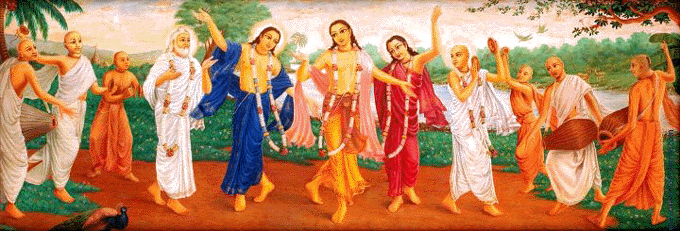
|
|
|
|
BY: SUN STAFF

Lord Caitanya's Sankirtana Dec 14, CANADA (SUN) — 'Vaisnavite Movements' from IGNOU curriculum, Part 6. Completing our series, today we offer the summation statement made in the Vaisnavism curriculum syllabus offered by the Indira Gandhi National Open University (IGNOU), followed by our own closing comments: Vaisnavism in India – Summing Up "Vaishnavism as a manifestation of bhakti ideology developed into a great religious movement in medieval India. The great Vaishnava Acharyas of southern India added new dimension to Vaishnavism by explaining the concept of bhakti based on theistic interpretation of the Vedanta. Interpreting bhakti in terms of the relationship between the Brahman, the Soul and the World and advocating for the path of devotion and surrender to the Lord as the ultimate objective in human life, the Acharyas brought a revolutionary change in Hindu religious tradition. They emphasized that faith and devotional love were superior to other forms of worship such as the performance of rites and ceremonies, self-mortification and pilgrimages. We should take note of the historical and social condition in which Vaishnavism made a major impact in our social life. The coming of Islam in medieval India and Sufi religious philosophy emphasizing social equality and brotherhood might have influenced the society at large. Some scholars have tried to correlate the development of Vaishnavism with these developments. It is also suggested that Vaishnavism was a social protest against the social inequality and ritualism practiced in Hinduism. Vaishnava saints struggled against the exclusive spirit of caste domination and asserted the dignity of the human soul as being independent of one's birth and social rank. There were revered Vaishnava saints who belonged to the lower orders of society. These saints stressed mutual trust and tolerance and love for all. Using local dialects and language in place of Sanskrit made Vaishnavism more acceptable among common people." Sun Editorial Comments on the Series: Readers who have been following this series and who are serious students of our Sampradaya's teachings will have the same impression that we have of this supposedly scholarly presentation from the Indira Gandhi National Open University. IGNOU is one of the most prestigious educational institutions in India, and one of the largest distance education providers in the world, therefore we can assume that their version of the history of Vaisnavism is being taught to a great many students, who assume the information is accurate. We can only wonder why the followers of Srila Prabhupada who have dedicated themselves to obtaining university degrees, and who have gotten a great deal of prestige and entitlement as a result of these educational credentials, have not taken IGNOU to task on this issue. Hopefully it is only because they have been unaware of what is being taught, and now that they are informed, they will take prompt action to remediate the situation. Many of our ISKCON pandits can speak the same scholarly language as the academics who wrote this syllabus, and they have been educated within our school of pure Vaisnavism. They should be writing articles with an aim to correct or challenge the authors of such curriculum material, in a very public way. This is our tradition. This is what our Acaryas have done in the past, including all three of our most recent Sampradaya Acaryas: Srila Bhaktivinoda Thakur, Srila Bhaktisiddhanta Saraswati Thakur, and Srila A.C. Bhaktivedanta Swami Prabhupada. I believe this is what Srila Prabhupada wanted from his preachers at the Bhaktivedanta Institute, and from those who have qualified themselves, at great expense of time and money, to obtain their academic degrees. Upon reading the IGNOU syllabus on Vaisnavism, it's obvious that these scholars do not accept one of the basic principles of the teachings of Bhagavad-gita: that Sri Krsna comes again and again in order to present the pure Absolute Truth. He does so by coming Himself, and as we know, the most recent Appearance of Krsna is Lord Caitanya Mahaprabhu, who was followed by several saktyavesa avatars, primarily being the Sampradaya Acaryas who continued on with Mahaprabhu's pure teachings. In the syllabus section on Eastern Vaisnavism, there is no mention of the fact that Lord Caitanya Mahaprabhu was an incarnation of Sri Krsna. Shankaracarya was an incarnation of Lord Shiva, but that reference is also missing from IGNOU's somewhat bewildering presentation on 'Shankaradeva'. The connection between Lord Caitanya's manifestation in Navadwip and the origination of Vaisnavism in Bengal is similarly misstated, and the representation of Madhavendra Puri as 'an emotional Sankarite who turned Caitanya towards Vaisnavism' is a useless mischaracterization of the Truth. Whether it be Vaisnavism in the south, west, north or east, there is no mention that the Supreme Personality of Godhead is the source of all these philosophical teachings and the true Cause and Founder of all the Vaisnava Sampradayas. This fact the IGNOU scholars have failed to appreciate and understand. This is indicative of the serious problems found within the scholastic world – the academics cannot accept that it is impossible to preach pure Krsna Consciousness or to teach the Absolute Truth unless you are empowered by the Source of that Truth. They themselves are too puffed up with their own self-importance to accept the fact that they cannot comprehend the way the Lord works as it pertains to the distribution of knowledge. We hope that this brief series will motivate our academically credentialed ISKCON pandits and the preachers at Srila Prabhupada's ISKCON New Delhi temple to make contact with the local IGNOU scholars, and to promptly engage them in whatever level of dialogue or debate is necessary so that this flawed curriculum material is improved and made accurate, and no future students are misled on this very important academic subject: the history of Vaisnavism in India.
| |